D-2 rocket complex with a P-13 ballistic missile
25 July 1955, the Council of Ministers decided to begin the development of a new ballistic missile designed to arm submarines. The creation of a new project was commissioned by OKB-1 / SRI-88, headed by SP The Queen. In the future, the role of the head developer was transferred to SKB-385, headed by V.P. Makeev. In addition, as subcontractors, several other organizations were involved in the project. So, TsKB-34 was supposed to develop a launcher for the new rocket, and NII-49 was responsible for creating the rocket instrumentation.
The second half of 1955 of the year went to OKB-1 specialists to create a preliminary design. At this stage, the main features of the promising complex and its rockets were identified, and several major proposals were made. For example, it was decided to unify the D-2 complex with the D-1 being developed at that time for the P-11FM rocket. It was assumed that the promising submarines carrying the P-13 missiles, in case of a delay in the creation of the latter, will be able to receive weapons in the form of the P-11FM, although this will require some modifications of the launcher. Further practice showed that such a proposal made sense.
The main element of the new missile system was to be the P-13 product (GRAU index 4K50). It was a short-range ballistic missile (according to the current classification), designed to attack coastal targets with previously known coordinates. The rocket was supposed to be launched from submarines at some distance from the coast and destroy the target with the help of a special warhead. An important feature of the project was its origin: the P-13 rocket became the first such domestic weapons, created specifically for use on submarines, and not converted from the existing "land" product.
The new rocket had special requirements that hampered its development. The product was supposed to have a length of no more than 12 m and a diameter up to 1,3 m. At the same time, the drop weight had to reach 1600 kg. Also, the rocket had to be distinguished by the durability of the structure, ensuring its storage in the filled form and launch in various conditions. Solving such problems required the project developers to apply a number of new ideas.
The P-13 product was a single-stage liquid ballistic missile with a detachable warhead and an autonomous inertial control system. Such an architecture made it possible to create weapons with the required combat characteristics suitable for use by the fleet.
The rocket received a cylindrical body of large elongation with a conical head fairing on which there were several protruding surfaces. A set of stabilizers was provided in the tail section of the hull. The head of the rocket was given under the placement of a special warhead. Behind it was the oxidizer tank, under which was the instrument compartment with a part of the control systems. The tail part of the body was given under the fuel tank and engine. To save weight, it was decided to make tanks carrying, making it possible to combine the power set of the rocket with fuel tanks. Another interesting innovation was the intermediate bottom in the upper tank (for the oxidizer), which ensured the correct balancing of the rocket regardless of fuel consumption.
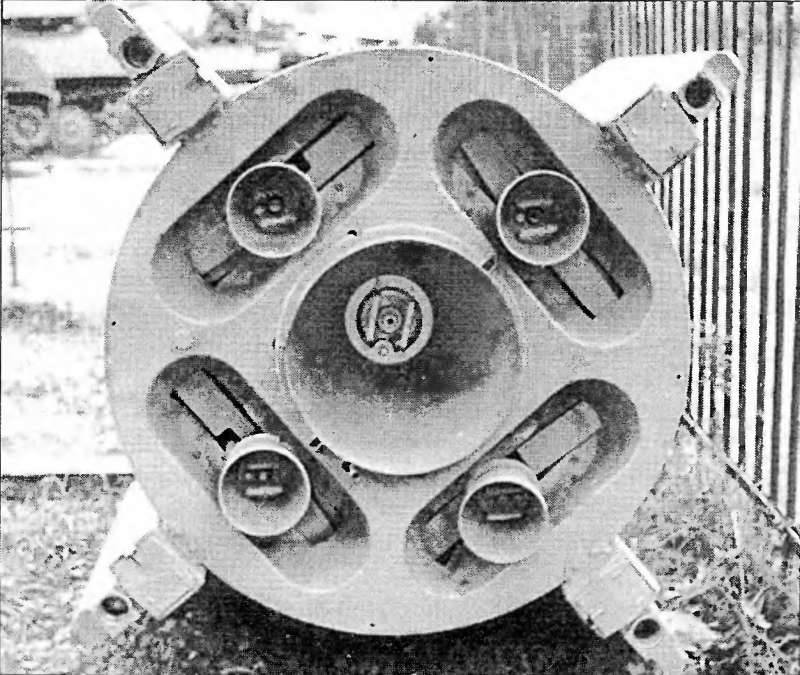
The tail of the rocket with engine nozzles. Well visible grooves for moving steering cameras. Photo Shirokorad AB "Weapons of the domestic fleet. 1945-2000"
For the R-13 rocket, a new C2.713 liquid engine with a 25,7 tonnage was developed, which worked on the fuel type TG-02 and the oxidizer AK-27I. The new engine had an original design, which to some extent improved the control of the rocket, as well as improved its other characteristics. The engine consisted of one large central sustainer and four lateral steering gears. By turning the steering cameras around the horizontal axis, the rocket could maneuver. The engine consisted of two turbopump units and two gas generators: one each for the cruiser and steering chambers.
In the interval between the fuel tanks and the oxidizer, near the center of gravity of the rocket, was placed the instrument compartment with the equipment of the control system. There was a set of gyroscopic instruments, the task of which was to monitor the position of the rocket in space. Due to the installation of gyroscopes near the center of gravity of the rocket, it was possible to significantly increase the efficiency of their work. According to the gyroscopes, the autopilot was supposed to generate commands for the drives of the engine steering cameras. Also, the autopilot had to monitor the duration of the flight and at the right time to turn off the engine, as well as drop the warhead with a warhead.
The head compartment of the P-13 / 4K50 rocket contained a nuclear warhead. Special combat equipment was placed in a compartment with a long conical head fairing, a short cylindrical body and a small conical tail fairing. At the last stabilizing ribs were provided. Inside the case was a nuclear combat unit with a power of 1 MT, developed at SRI-1011. Interestingly, at the stage of development of the warhead there were problems with the integration of the charge into the existing body. For this reason, the specialists of SRI-1011 and SKB-385 had to change the layout of the nuclear weapon in order to properly fit inside the body. In this case, the body of the warhead and nuclear charge now represented a single unit. The discharge of the head part was to be carried out using a powder pusher.
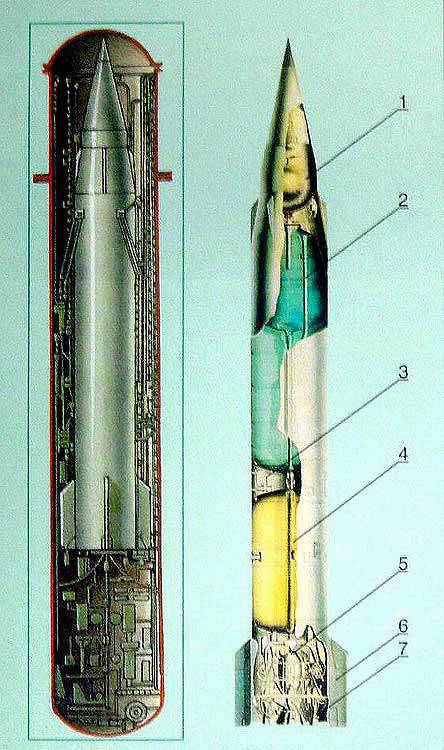
Scheme of the launcher with a missile (left) and missiles P-13 (right). 1 - warhead; 2 - oxidizer tank; 3 - instrument compartment; 4 - fuel tank; 5 - engine sustainer, 6 - stabilizers; 7 - steering camera. Figure Rbase.new-factoria.ru
A training version of the warhead was also developed. She was distinguished by the absence of a fissile material, but received a complete set of other equipment, including an 300-kg initiating explosive charge. The head part with such equipment was proposed to be used in trials and during training launches.
The P-13 rocket had a length of 13,745 m and a case diameter of 1,3 m. The span of the stabilizers was 1,91 m. The dry mass of the rocket was determined at the level of 3730 kg. The maximum starting weight is 13,745 t, of which more than 2300 kg accounted for fuel and more than 7770 kg for oxidizer.
The product could reach speeds in excess of 2 km / s and due to this rise to an altitude up to 145 km. The maximum firing range was 600 km. The minimum launch range - 148 km. It took a little more than 7 minutes to fly to the maximum range. The circular deviation when shooting at the maximum range was 4 km.
The submarine carrier rocket P-13 was supposed to receive a set of special equipment for the storage and use of weapons. The main element of the D-2 complex was the CM-60 launcher based on the launch pad. It was proposed to transport the rocket inside the mine of appropriate sizes. Inside the shaft was placed a movable launching table with chain hoists for taking the rocket out of storage. The launch pad mounted on a lifting device had a turntable with holding devices for the rocket. With the help of this platform it was proposed to perform the guidance of the rocket in azimuth.
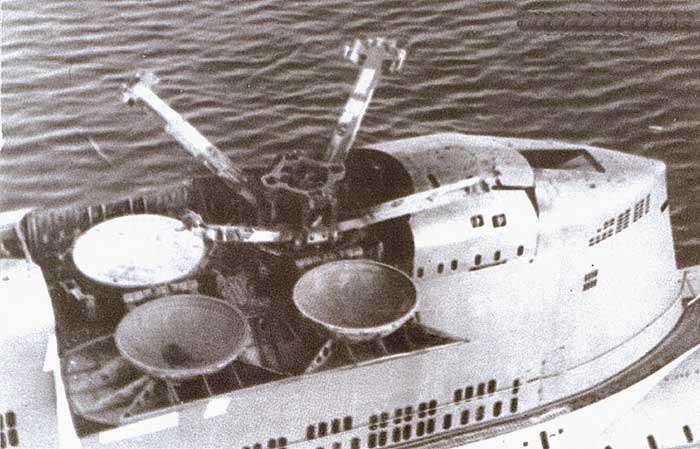
Launcher of the submarine pr. 629 immediately after the launch of the rocket. Rack-grips divorced. Photo Rbase.new-factoria.ru
On the launch pad were mounted four rack-capture, holding the rocket in a vertical position. Starting the ascent, the rocket had to initiate an automatic dilution of the struts with a spring mechanism. After start automatic equipment had to put them. In an emergency, the crew of the submarine could throw a missile overboard. To do this, a command was issued, according to which the pneumatic actuator had to shift the frame on the launch pad. The latter tilted the rocket to starboard to unacceptable angles, after which it had to break loose from the bindings and fall into the water.
For the calculation of the flight program and the introduction of data into the rocket automatics it was proposed to use the Dolomite device. The issuance of coordinates for the use of rockets was to be carried out by the standard navigation system of the boat carrier. Different carriers received various means of navigation.
Also in the complex D-2 included some funds intended for use ashore, in preparing the submarine to enter the combat duty. The complex’s onshore facilities included special containers for transporting missiles and combat units, tankers, tractors, etc. With the help of these systems, it was intended to load rockets on a submarine and carry out refueling, as well as conduct a survey of the product after the submarine returned from duty.
Before the submarine went out to sea, it was necessary to load rockets and refuel them. In connection with the specific features of the used fuel pair, it was proposed to fill the rocket only with an oxidizer. The fuel was to be stored in a separate tank on the submarine and poured into the tank of the rocket only during the pre-launch preparation. It was allowed to store the rocket in the filled state for three months. After that, it was necessary to drain the oxidizer, unload the rocket and check the status of its tanks. Having passed the inspection, the rocket could once again load onto the submarine.
Before firing, the crew of the submarine had to calculate the flight mission and enter it into the rocket autopilot. In addition, at this time made filling tanks. Immediately before launching the boat had to emerge and open the cover of the launcher. Further, with the help of a lift, the rocket was removed from the submarine. At the start command, the engine was turned on. As well as in the previous project, some new units and techniques were proposed, which made it possible to reduce the effect of pitching on the launch of the rocket. Due to their use, it was allowed to start at carrier speeds up to 15 nodes and when rolling up to 5 points. Starting the engine and its output to the nominal mode was made taking into account the position of the submarine and the launcher.
It took about 4 minutes to prepare the rocket for launch after boating the boat. Immediately after launching one missile, the submarine could begin preparations for a new shooting. In this case, the already used launch pad was returned to the mine, and it was covered with a lid, after which the preparation of the new launcher began or the dive was made. After 12-15 minutes after the ascent of the submarine, making a volley with three missiles, it could return to a submerged position.

Diagram of diesel electric submarines pr 629. Visible keel unit required to accommodate launchers. Figure Wikimedia Commons
In 1957-58, the works on projects Р-13А and Р-13М started, the purpose of which was to increase the characteristics of the Р-13 / 4К50 rocket. Detailed information about the features of the project P-13A missing. Work on the P-13M project continued for some time, after which they were stopped in favor of other projects with great prospects.
Since the middle of 1954, work has been carried out on several projects of promising submarines that were proposed to be equipped with new missile systems. Among others, in TsKB-16 under the leadership of N.N. Isanina developed a project of a diesel-electric submarine 629. The initial version of this project did not receive approval, which is why in 1956, the development of a new submarine actually began anew. The new project involved the construction of submarines capable of carrying the D-1 and D-2 complexes with the P-11FM and P-13 missiles, respectively.
For the operation of the new missiles, the submarine of the 629 project was to receive the Dolomit system, and a Sigma complex with an Lira-type astronavigation periscope was proposed for navigation. Three CM-60 launchers were to be located in the fourth compartment of the submarine, inside the hull and solid chopping. To accommodate long launchers, a large protruding unit appeared on the bottom of the case.
Also in 1956, the design of the nuclear submarine “658” began, which also had to become the carrier of the P-13 missiles. This project was created in TsKB-18 under the guidance of S.N. Kovalev. The new submarines were to receive the Dolomite-1 control system with an azimuth and Mars-629 distance control. For navigation, it was proposed to use the Pluto-658 complex. In view of the relatively large dimensions of the submarine, it was possible to dispense with any units protruding beyond the limits of the light hull.
In 1957, the development of the 660 project began. Such a submarine was supposed to use a power plant using sodium supraperoxide. It was assumed that with the help of new engines, the boat would be able to reach underwater speed up to 15 knots or overcome up to 2800 miles at economic speed. Submarines project 660 had to carry three missiles P-13. By the middle of 1958, a preliminary version of the project was developed, the analysis of which showed the futility of development. Differing in complexity, the new submarine was supposed to yield to the existing boats in terms of its main characteristics. Further work on the project was considered meaningless.
A set of necessary documentation for the D-2 complex was prepared at the beginning of 1957. Shortly thereafter, preparation for testing of individual units and the rocket as a whole began. Over the next few months, various tests of a prospective warhead, control systems, etc. were conducted. In December, the 1959 of the year began testing the C2.713 engine. By the spring of next year, all the individual tests had been completed, which made it possible to begin preparations for the P-13 rocket assembly.
In June 1959, the first experimental products Р-13 / 4К50 were delivered to the Kapustin Yar test site. The first rocket launches were carried out from a fixed stand, after which the checks on the bobbing stand, simulating the rocking of the submarine, began. Until March, 1960 completed 19 launches at the test site, of which 15 were considered successful. By that time, checks had already begun on the missile system as part of the equipment of the submarine.
In November, 1959, one of the submarines of the 629 project, which served as part of the Northern Fleet, received a full set of equipment necessary to operate the P-13 missiles. Test shooting continued until August 60-th. During this time, 13 missiles were expended. 11 products completed their tasks, two more launches were emergency.
In the late summer and early autumn of 1960, unusual tests of the D-2 complex with the P-13 rocket took place in the Kola Bay. For them, a full-scale mock-up of the 629 submarine's compartment with all the units of the missile complex was built. At various distances from the compartment, depth charges, mines, etc. were installed, imitating various anti-submarine anti-enemy weapons. In the course of six tests, new requirements were formed, which made it possible to increase the security of rockets against the enemy attack. In particular, it was based on the results of these tests that it was finally decided to abandon the storage of fuel directly in the rocket.
After completion of the complex, according to the results of all tests, the D-2 system was again checked, which opened the way for its use by the fleet. October 13 1961, the D-2 missile system with the P-13 ballistic missile was adopted as part of the submarine capabilities of the 629 and 658 projects. From December 1959 to December the 1962 Navy of the Soviet Union received the 23 submarines of the 629 project. In the same period, the combat strength of the Navy was replenished with eight atomic submarines of the 658 project.
The operation of the D-2 rocket complex continued until the early seventies. During this period, the carrier submarines performed 311 rocket launches. 225 shooting ended with a successful defeat of training targets. According to reports, the 38 failed start was due to personnel errors and malfunctions of various systems. Causes 10 remaining failures could not be established.
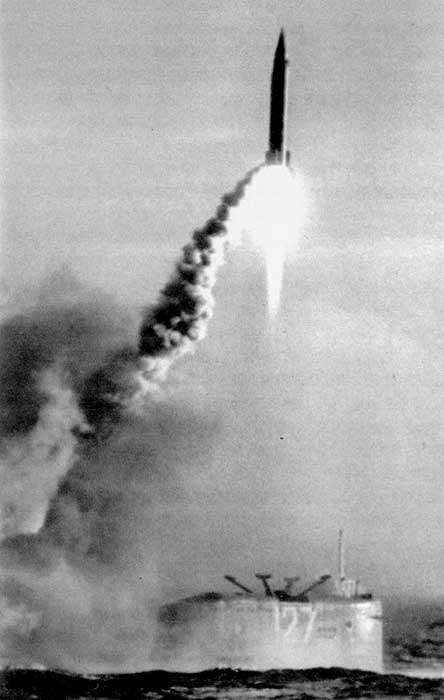
The launch of the P-13 rocket. Photo Rbase.new-factoria.ru
Of particular interest is the launch, performed by the submarine of the project 629 20 in October 1961 of the year. During the exercises with the code name "Rainbow", one of the submarines of the Northern Fleet fired a P-13 rocket with a regular special combat unit. A nuclear warhead successfully hit a conventional target at the range on Novaya Zemlya. According to open sources, it was the only case of using the P-13 rocket in a full-fledged combat configuration. Moreover, before or after the event "Raduga" domestic submarines never fired ballistic missiles with nuclear warheads.
Rocket R-13 was designed specifically for use by submarines. Such an approach to the creation of new weapons fully justified itself. From the previous P-11FM, the new P-13 rocket was distinguished by increased reliability as well as higher performance. The product 4K50 was able to deliver a combat unit with a power of 600 Mt to a distance of 1 km. Nevertheless, it was not possible to get rid of the main drawback of the previous development in the form of a surface start. This feature of the D-2 complex, in particular, led to a noticeable lag behind foreign counterparts.
The growth of the main characteristics of the rocket, as well as the massive construction of carrier submarines, have significantly increased the impact potential of the naval component of the strategic nuclear forces. It was thanks to the D-2 complex with the P-13 rocket that it was possible to launch full-fledged patrols near the territory of the likely enemy and thereby reduce the existing lag in nuclear armaments.
The creation and operation of the D-2 complex with the P-13 rocket became an important stage in the development of domestic weapons for the navy. The solutions implemented in the P-13 project were later used to create new types of similar weapons. After the removal of the D-2 complex from service, the operation of its carriers continued. Submarines of the 629 and 658 projects were rebuilt according to updated projects and became carriers of new missile weapons.
Based on:
http://rbase.new-factoria.ru/
http://russianarms.ru/
http://makeyev.ru/
http://arms.ru/
https://defendingrussia.ru/
Shirokorad A.B. Weapons of the domestic fleet. 1945-2000. - Minsk: “Harvest”, 2001
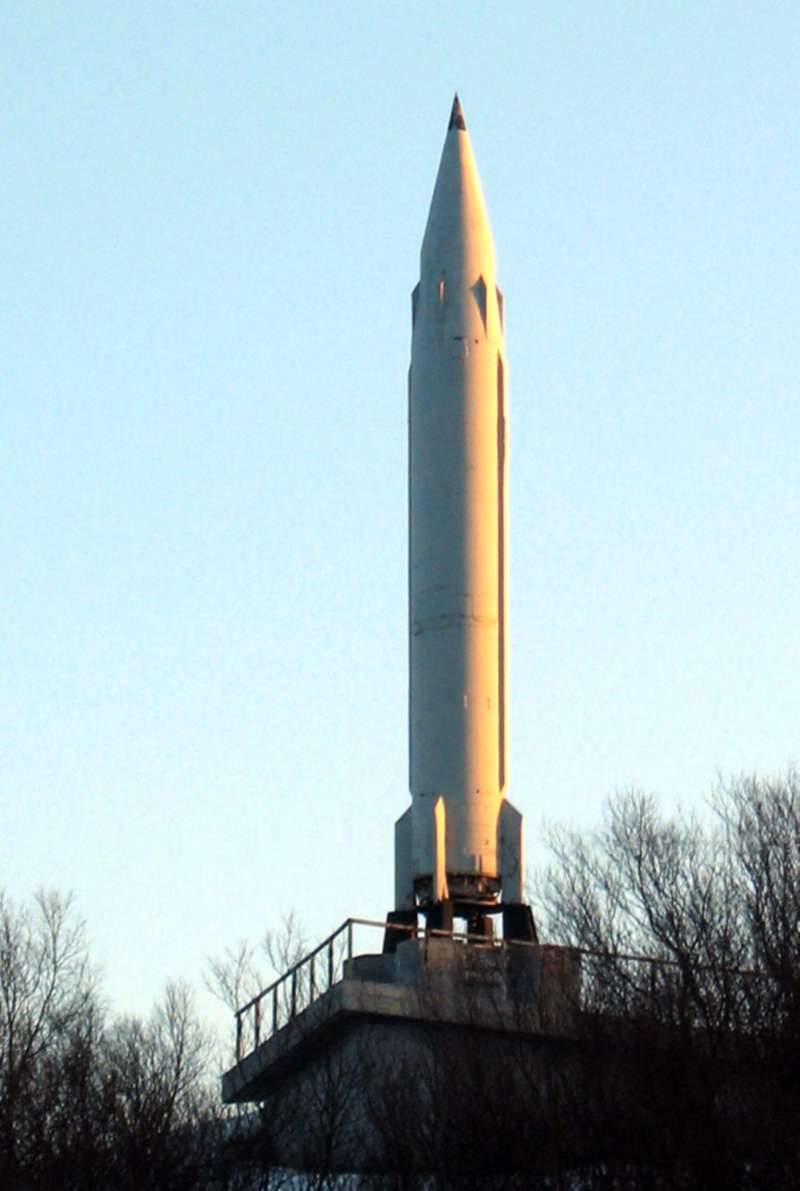
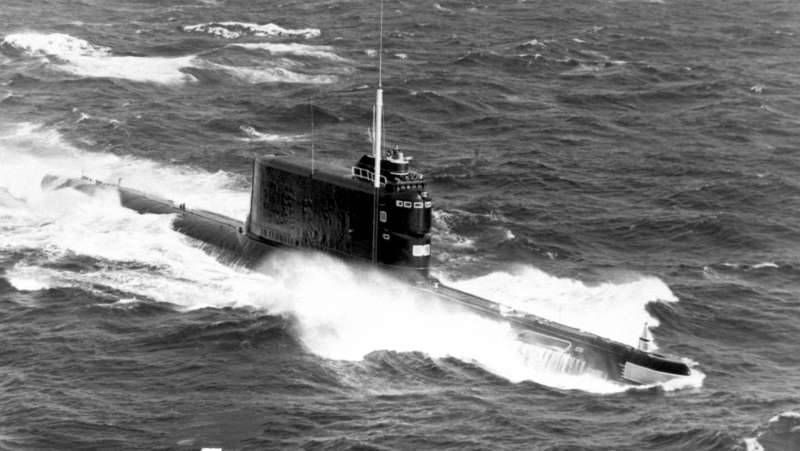

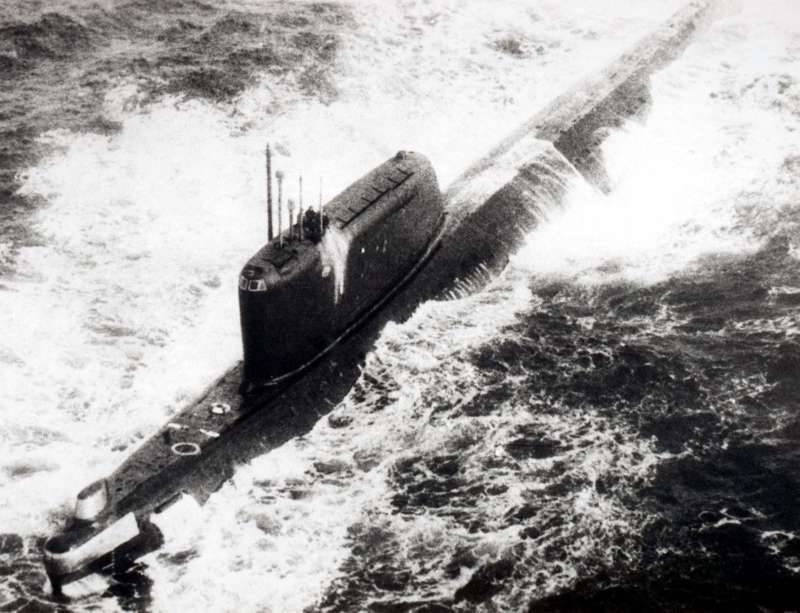
Information